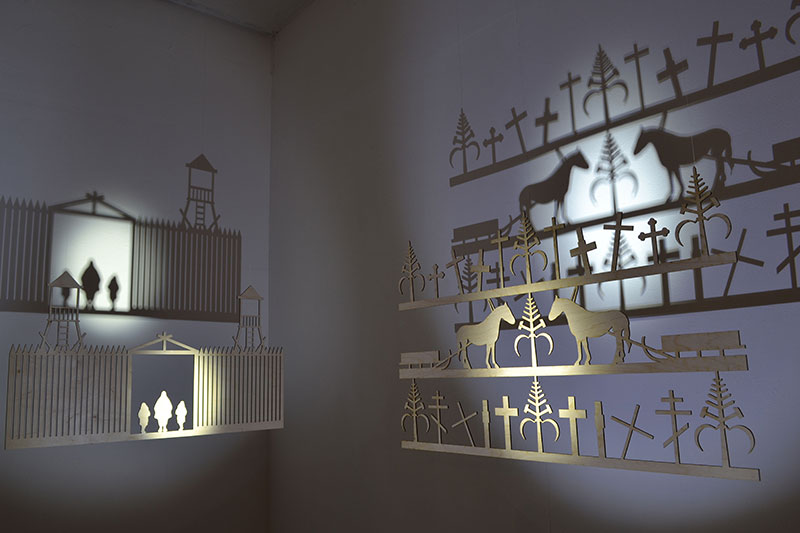
The last major railway station on the freezing journey from Poland was Kotlas in Arkhangelsk (Archangel region). This was not the end of the journey, since Anna’s family travelled on for a few hours to a labour camp (or posiolek) called Kopytovo which consisted of bleak barracks with families sharing cramped living space. There they endured more dreadful conditions, with little possibility for hygiene. They were plagued by bugs and vermin that multiplied easily in the barracks.
Diana Forster has again turned to irony – in the form of a parody propaganda poster – to capture the horror of arriving at this camp. In the picture to the right, the slogan ‘Kopytovo: Here you shall live!’ is enforced by the point of a bayonet. The oversize guard looms over the figures of a parent and child, as they stand at the threshold of imprisonment. That liminal moment cannot last long: a world of watch towers and hard labour amongst the ‘gulag trees‘ awaits them within the camp. This poster tells a very different story from the positive images of happy ‘workers’ that can be seen in early 20th-century posters celebrating the Russian Revolution.
Diana has also used other media to visualise life in Kopytovo. In Siberian Exile (2016), she appropriated the symmetry and gentle, naive imagery of the Polish craft of wycinanki to create six laser-cut panels from Russian birch plywood that tell the story of her mother’s deportation and incarceration. Wycinanki is the traditional Polish craft of cutting folded coloured paper with sheep shears to make intricate and attractive pictures, and was used to decorate the walls of people’s houses. Ironically here it is used to depict a very different kind of shelter – a prison camp, not a family home. These panels were suspended and front-lit to cast shadows on the walls behind, giving extra depth to the images
At first glance, the delicate filigree of the woodwork and the images of horses and trees conjure a benign rural picture; but the panel on the right shows a cemetery at the camp, commemorating the fact that many of the refugees died as a result of the harsh conditions in which they were forced to live and work, in temperatures as low as -40°C. In the panel on the left, the three figures silhouetted in the camp entrance are loomed over by watchtowers that grow larger in the shadows. The horrors of war and deportation are clearly evoked here, with ordinary people hemmed in by sinister, unrelenting structures. The entrance to the camp is sandwiched by sharpened fence posts, and the guard posts make escape impossible. You can see more panels in the series here.
